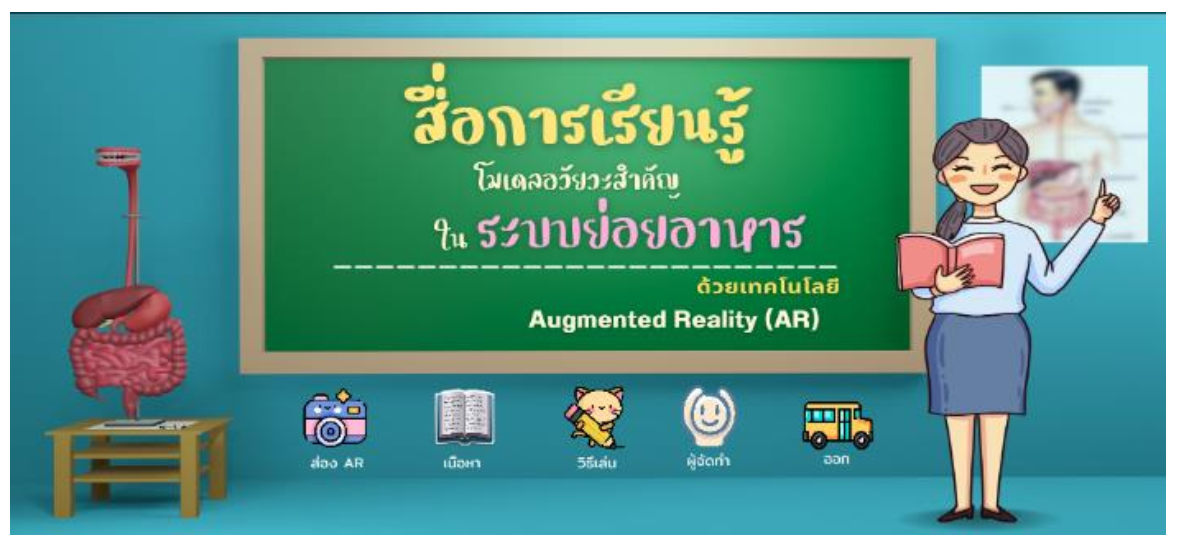Mobile Application with Augmented Reality Technology for Digestive System Learning of Upper-Primary School Students
Main Article Content
Abstract
The objectives of this research were fourfold: 1) to develop a mobile application using augmented reality technology for teaching the digestive system to upper-primary school students, 2) to assess the effectiveness of the mobile application in facilitating digestive system learning, 3) to evaluate performance using the E1/E2 formula during the use of the mobile application, and 4) to assess satisfaction with the mobile application for digestive system learning. The development process followed the Software Development Life Cycle (SDLC), utilizing the C# language in the Visual Studio Code Program and creating models with the Unity and Blender Programs. The research employed various assessment tools, including performance evaluations by five experts, pre-test and post-test assessments from 18 students, and satisfaction assessments from a sample of 58 individuals using cluster sampling selection methods. Statistical measures used included mean, standard deviation, and the efficiency criteria of 80/80 using the E1/E2 formula. The findings revealed that the mobile application for digestive system learning for upper-primary school students, incorporating augmented reality technology, featured a total of eight models. The application operated in two ways: 1) users could learn by scanning through Marker sheets, and 2) learning by selecting content from the menu could serve as a learning medium for students, enabling individuals interested in the topic to learn at any time. Considering the results of the evaluation, the overall efficiency was at the highest level (=4.90, S.D.=0.17), with E1/E2 efficiency at 80.56/83.89, surpassing the required performance. Academic achievement demonstrated a statistically significant increase in post-test scores compared to pre-test scores at a p-value of .05. User satisfaction among the sample was reported at the highest level (
=4.75, S.D.=0.45). In conclusion, this application is a practical and suitable study material for students and individuals interested in the topic, allowing flexible learning opportunities at any time. It can be used as teaching material in science learning groups and proves useful for schools, helping to reduce the cost of purchasing study materials for students.
Article Details

This work is licensed under a Creative Commons Attribution-NonCommercial-NoDerivatives 4.0 International License.
All authors need to complete copyright transfer to Journal of Applied Informatics and Technology prior to publication. For more details click this link: https://ph01.tci-thaijo.org/index.php/jait/copyrightlicense
References
Azrina, K., Jhi-Zhi, L., & Muhammed-Dzulkhiflee, H. (2021). The development of mobile augmented reality application to facilitate high school students with various learning strategies in learning history. Turkish Journal of Computer and Mathematics Education, 12(3), 2199–2204. https://www.proquest.com/openview/2842178e219665f6e115a3d32278bec6/1?pq-origsite=gscholar&cbl=2045096
Brahmawong, C. (2013). Developmental testing of media and instructional package. Silpakorn Educational Research Journal, 5(1), 7-20. https://old.educ.su.ac.th/2013/images/stories/081957-02.pdf [In Thai]
Bunpalwong, M. (2021). Development of Virtual Alphabet Learning Media System to Improve Early Childhood Reading Skill. Interdisciplinary Sripatum Chonburi Journal, 7(3), 108-120. https://so04.tci-thaijo.org/index.php/ISCJ/article/view/253153/173414 [In Thai]
Digital Government Development Agency. (2023). Thailand digital government development plan 2023-2027. Retrieved 5 November 2024, from https://www.dga.or.th/policy-standard/policy-regulation/dga-019/dga-027/dg-plan-2566-2570/. [In Thai]
Juan, M.C. et al. (2019). An augmented reality app to learn to interpret the nutritional information on labels of
real packaged foods. Frontiers in Computer Science, 1, https://doi.org/10.3389/fcomp.2019.00001
Khathong N., Tiamkaew, E., & Khruahong, S. (2020). The development of augmented reality technology applications for learning about element and chemical compounds. Journal of Applied Informatics and Technology, 2(2), 77-87. https://doi.org/10.14456/jait.2020.6 [In Thai]
Montreesree, S. & Sovajassatakul, T. (2019). A development of augmented reality media on animation creation for grade 11 students. Journal of Industrial Education, 18(2),40-47. [In Thai]
Phiwma, N. & Mutchima, P. (2018). The development of the augmented reality application for arts, culture and local wisdom learning support on Alms Bowl Making at Ban Batra community. Parichart Journal, 31(1). 241–262. [In Thai]
Renaldy, R. & Zakiah, A. (2020). Development mobile application of Bandung Tempo Doeloe based on augmented reality using GPS tracking method. International Journal of Information Engineering and Electronic Business (IJIEEB), 12(2), 9-14. https://doi.org/10.5815/ijieeb.2020.02.02
Ruangkulsap, P., Butkote, S., & Inlupet, I. (2022). Mobile application development for learning basic Japanese vocabulary with augmented reality. NEU Academic and Research Journal, 12(2), 298-312. https://so04.tci-thaijo.org/index.php/neuarj/article/view/258580/175896 [In Thai]
Sampaothong, T. & Sanchana, W. (2023). The development application promote agritourism of Pakdee Farm with augmented reality technology. Journal of Applied Informatics and Technology, 5(1), 71-85. https://doi.org/10.14456/jait.2023.6 [In Thai]
Tan, Y. et al. (2022). Augmented and virtual reality (AR/VR) for education and training in the AEC industry: A systematic review of research and applications. Buildings, 12(10), 1529. https://doi.org/10.3390/buildings12101529.
Weerapan, D. (2018). Management information system for instructional via web applications. Journal of Information Technology Management and Innovation, 5(1), 145-154. https://ph02.tci-thaijo.org/index.php/itm-journal/article/view/140243/104026 [In Thai]
Wungkahad, P. (2023). Learning unit information on the digestive system for science subjects. [Interview], Chumchonbankhamcha-i School, Khamcha-i, Mukdahan Province, Thailand. [In Thai]
Xie, J. et al. (2022). Trends of augmented reality for Agri-Food applications. Sensors, 22(21), 8333, https://doi.org/10.3390/s22218333.
Yadav, N. & Sinha, A. (2022). Augmented reality and its science. International Journal of Education and Management Engineering (IJEME). 12(6). https://doi.org/10.5815/ijeme.2022.06.04
Yong, S. W. & Sung, A.N. (2019). A mobile application of augmented reality for aircraft maintenance of fan cowl door opening. International Journal of Computer Network and Information Security (IJCNIS). 11(6), 38-44. https://doi.org/10.5815/ijcnis.2019.06.05
Yothapakdee, K. & Sributtha, K. (2021). Public relation media in augmented reality of unseen Muang-Loei attractions with bird eye view via drone technology. Srinakharinwirot University (Journal of Science and Technology), 13(26), 1-13. https://ejournals.swu.ac.th/index.php/SWUJournal/article/view/14107 [In Thai]
Zheng, J. et al. (2024). Research and application of augmented reality technology and digital media Technology in mobile visual media. Applied Mathematics and Nonlinear Sciences, 9(1), https://doi.org/10.2478/amns.2023.1.00154.






